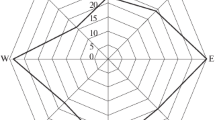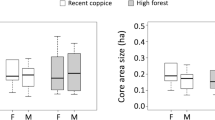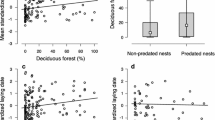Abstract
One of the most important structures for an individual’s survival is a refuge, especially for species subject to significant predatory pressure or living in environments affected by severe climatic conditions. We studied how wood mice (Apodemus sylvaticus), inhabiting a Mediterranean environment, use nests and the factors that could be determining this use. Radio-tracking of 16 mice allowed us to detect 24 diurnal nests, which were used with a high fidelity rate (1.75 nests/animal). Nest sites that had been identified using radio-tracking were matched with 24 randomly selected non-nest sites (located within an area defined by the sum of all individual home ranges), and all sites were characterized according to their macro- and micro-habitat parameters. Using a generalized linear model, we tested three hypotheses: (1) a nest’s use is influenced by its proximity to food patches; (2) the degree of sheltering provided by each site influences its use; and (3) nest use is constrained by a combination of food- and shelter-related features. Females had higher nest fidelity than males, and the degree of sheltering provided by each site had a positive significant influence on its use. Nests offering higher protection (e.g., under thick vegetation), good drainage (e.g., sleep slopes), and lower human and predatory disturbance (far from orchards) were most often used. The proximity to food patches seemed to negatively influence nest use. Results indicate the need to preserve patches of natural dense vegetation near riparian habitats, which is in agreement with the focus of mammalian protection plans in Mediterranean agricultural landscapes. These patches are important areas for Apodemus sylvaticus, an acorn disperser species, which is preyed on by raptors and mammalian carnivores.
Similar content being viewed by others
References
Bontzorlos VA, Peris SJ, Vlachos CG, Bakaloudis DE (2005) The diet of barn owl in the agricultural landscapes of central Greece. Folia Zool 54(1–2):99–110
Burnham KP, Anderson DR (2004) Multimodel inference—understanding AIC and BIC in model selection. Sociol Methods Res 33(2):261–304
Caughley G, Sinclair ARE (1994) Wildlife ecology and management. Blackwell Science, Cambridge
de Mendonça PG (2006) Observations on the nesting habits of Apodemus sylvaticus in woodlands. Hystrix Ital J Mamm (n.s.) 85 (Suppl)
Goméz JM, Puerta-Piñero C, Schupp EW (2008) Effectiveness of rodents as local seed dispersers of holm oaks. Oecologia 155:529–537. doi:10.1007/s00442-007-0928-3
Guisan A, Edwards TC Jr, Hastie TJ (2002) Generalized linear and generalized additive models in studies of species distributions: setting the scene. Ecol Model 157:89–100
Gurnell J, Flowerdew JR (2006) Live trapping of small mammals. A practical guide. The Mammal Society, London
Jacob J (2008) Response of small rodents to manipulations of vegetation height in agro-ecosystems. Integr Zool 3:3–10. doi:10.1111/j.1749-4877.2008.00078.x
Jensen TS, Nielsen OF (1986) Rodents as seed dispersers in a heath-oak wood succession. Oecologia 70:214–221
Kasprzykowski Z, Golawski A (2006) Habitat use of the barn owl Tyto alba and the little owl Athene noctua in central eastern Poland. Biol Lett 43(1):33–39
Khammes N, Aulagnier S (2007) Diet of the wood mouse, Apodemus sylvaticus, in three biotopes of Kabylie of Djurdjura (Algeria). Folia Zool 56:243–252
Korpimäki E, Koivunen V, Hakkarainen H (1996) Do radio-collars increase the predation risk of small rodents? Ethol Ecol Evol 8:377–386
Kozakiewicz M, Gortat T, Kozakiewicz A, Barkowska M (1999) Effects of habitat fragmentation on four rodent species in a Polish farm landscape. Landsc Ecol 14:391–400
Krystufek B, Griffiths HI (2002) Species richness and rarity in European rodents. Ecography 25:120–128
Lebreton J-D, Hines JE, Pradel R, Nichols JD, Spendelow JA (2003) Estimation by capture–recapture of recruitment and dispersal over several sites. Oikos 101:253–264
Loureiro F (2008) Time and space use of key resources by the Eurasian badger (Meles meles) in a Mediterranean cork oak woodland: conservation implications. PhD Thesis, University of Lisbon, Lisbon
Loureiro F, Bissonette JA, Macdonald DW, Santos-Reis M (2009) Temporal variation in the availability of Mediterranean food resources: do badgers Meles meles track them? Wildl Biol 15:197–206. doi:10.2981/07-046
Martín J, López P (1999) When to come out from a refuge: risk sensitive and state dependent decisions in an alpine lizard. Behav Ecol 10(5):487–492
Matos H, Santos-Reis M (2006) Distribution and status of the pine marten Martes martes in Portugal. In: Santos-Reis M, Birks JDS, O’Doherty EC, Proulx G (eds) Martes in carnivore communities. Alpha Wildlife, Alberta, pp 47–61
Mech LD (1983) Handbook of animal radio-tracking. University of Minnesota, Minneapolis
Montgomery WI (1989) Population regulation in the wood mouse, Apodemus sylvaticus. I. Density dependence in the annual cycle of abundance. J Anim Ecol 58:465–475
Morris DW (1980) An elementary guide to practical aspects of radio tracking mammals. In: Amlaner CJ, Macdonald DW (eds) A handbook on biotelemetry and radio tracking. Pergamon, New York, pp 161–168
Morrison ML, Marcot BG, Mannan RW (1998) Wildlife-habitat relationships: concepts and applications. The University of Wisconsin Press, Madison
Prenda J, López-Nieves P, Bravo R (2001) Conservation of otter (Lutra lutra) in a Mediterranean area: the importance of habitat quality and temporal variation in water availability. Aquat Conserv Mar Freshw Ecosyst 11:343–355. doi:10.1002/aqc.454
R Development Core Team (2005) R: a language and environment for statistical computing. R Foundation for Statistical Computing, Vienna, Austria. http://www.R-project.org. ISBN 3-900051-07-0
Real R, Barbosa AM, Rodríguez A, García FJ, Vargas JM, Palomo LJ, Delibes M (2009) Conservation biogeography of ecologically interacting species: the case of the Iberian lynx and the European rabbit. Divers Distrib 15:390–400. doi:10.1111/j.1472-4642.2008.00546.x
Remonti L, Balestrieri A, Prigioni C (2006) Factors determining badger Meles meles sett location in agricultural ecosystems of NW Italy. Folia Zool 55(1):19–27
Revilla E, Palomares F, Fernández N (2001) Characteristics, location and selection of diurnal resting dens by Eurasian badgers (Meles meles) in a low density area. J Zool Lond 255:291–299. doi:10.1017/S0952836901001388
Rosalino LM, Santos-Reis M (2002) Feeding habits of the common genet Genetta genetta in a man-made landscape of central Portugal. Mammalia 66(2):195–205
Rosalino LM, Loureiro F, Macdonald DW, Santos-Reis M (2005a) Dietary shifts of the badger Meles meles in Mediterranean woodlands: an opportunistic forager with seasonal specialisms. Mamm Biol 70(1):12–23
Rosalino LM, Macdonald DW, Santos-Reis M (2005b) Resource dispersion and badger population density in Mediterranean woodlands: is food, water or geology the limiting factor? Oikos 110:441–452. doi:10.1111/j.0030-1299.2005.13755.x
Rosalino LM, Macdonald DW, Santos-Reis M (2005c) Activity rhythms, movements and patterns of sett use by badgers, Meles meles, in a Mediterranean woodland. Mammalia 69:395–408
Rosalino LM, Rosário J, Santos-Reis M (2009) The role of habitat patches on mammalian diversity in cork oak agroforestry systems. Acta Oecol 35:507–512. doi:10.1016/j.actao.2009.03.006
Rosalino LM, Ferreira D, Leitão I, Santos-Reis M (2010) Usage patterns of Mediterranean agro-forest habitat components by wood mice Apodemus sylvaticus. Mamm Biol. doi:10.1016/j.mambio.2010.08.004
Rosário IT, Mathias ML (2004) Annual weight variation and reproductive cycle of the wood mouse (Apodemus sylvaticus) in a Mediterranean environment. Mammalia 68:133–140
Santos X, Llorente GA, Pleguezuelos JM, Brito JC, Fahd S, Parelladas X (2007a) Variation in the diet of the Lataste’s viper Vipera latastei in the Iberian Peninsula: seasonal, sexual and size-related effects. Anim Biol Leiden 57(1):49–61. doi:10.1163/157075607780001998
Santos MJ, Pinto BM, Santos-Reis M (2007b) Trophic niche partitioning between two native and two exotic carnivores in SW Portugal. Web Ecol 7:53–62
Santos-Reis M, Correia A I (eds) (1999) Caracterização da flora e da fauna do montado da Herdade da Ribeira Abaixo (Grândola-Baixo Alentejo). Centro de Biologia Ambiental, Lisboa
Sarà M (2008) The use of artificial nest-boxes by Apodemus sylvaticus dichrurus in Sicily. Folia Zool 57:294–299
Sawada M (1999) ROOKCASE: an Excel 97/2000 Visual Basic (VB) add-in for exploring global and local spatial autocorrelation. Bull Ecol Soc Am 80:231–234
Schradin C (2005) Nest-site competition in two diurnal rodents from the Succulent Karoo of South Africa. J Mamm 86(4):757–762
Sheffield SR, King CM (1994) Mustela nivalis. Mammalian Species 454:1–10
Siegle S, Castellan NJ (1988) Nonparametric statistics for the behavioural sciences. McGraw-Hill, New York
Soné K, Kohno A (1999) Acorn hoarding by the field mouse, Apodemus speciosus Temminck (Rodentia: Muridae). J For Res 4:167–175
Tabachnick BG, Fidell LS (1996) Using multivariate statistics. Harper Collins College, New York
Tew TE, Todd IA, Macdonald DW (2000) Arable habitat use by wood mice (Apodemus sylvaticus). 2. Microhabitat. J Zool (Lond) 250:305–311. doi:10.1111/j.1469-7998.2000.tb00774.x
Virgós E (2001) Relative value of riparian woodlands in landscapes with different forest cover for medium-sized Iberian carnivores. Biodivers Conserv 10:1039–1049
Virgós E, Llorente M, Cortés Y (1999) Geographical variation in genet (Genetta genetta L.) diet: a literature review. Mamm Rev 29(2):119–128
Wolton RJ (1985) The ranging and nesting behaviour of wood mice, Apodemus sylvaticus (Rodentia: Muridae), as revealed by radio-tracking. J Zool 206:203–222
Ylönen H, Altner H-J, Stubbe M (1991) Seasonal dynamics of small mammals in an isolated woodlot and its agricultural surroundings. Ann Zool Fenn 28:7–14
Zar JH (1999) Biostatistical analysis. Prentice Hall, New Jersey
Zgrabczyńska E, Piłacińska B (2002) Social relations in family-groups of wood mice Apodemus sylvaticus under laboratory and enclosure conditions. Acta Theriol 47(2):151–162
Acknowledgments
The study was funded by the Fundação para a Ciência e a Tecnologia and Fundo Social Europeu (III Quadro Comunitário de Apoio) (Research Contract POCI and PPCDT/BIA-BDE-61122/2004; LMR Postdoctoral fellowship: SFRH/BPD/14435/2003 and SFRH/BPD/35842/2007). Special thanks are due to Carla Gheler-Costa for the help in the trapping campaign, Maria J. Santos for the comments on an early draft, and Sarah Perkins for manuscript revision.
Author information
Authors and Affiliations
Corresponding author
About this article
Cite this article
Rosalino, L.M., Ferreira, D., Leitão, I. et al. Selection of nest sites by wood mice Apodemus sylvaticus in a Mediterranean agro-forest landscape. Ecol Res 26, 445–452 (2011). https://doi.org/10.1007/s11284-010-0797-9
Received:
Accepted:
Published:
Issue Date:
DOI: https://doi.org/10.1007/s11284-010-0797-9




